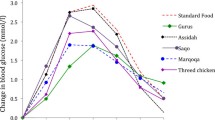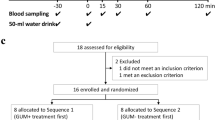Abstract
Purpose
There are wide inter-individual differences in glycemic response (GR). We aimed to examine key digestive parameters that influence inter-individual and ethnic differences in GR in healthy Asian individuals.
Methods
Seventy-five healthy male subjects (25 Chinese, 25 Malays, and 25 Asian-Indians) were served equivalent available carbohydrate amounts (50 g) of jasmine rice (JR) and basmati rice (BR) on separate occasions. Postprandial blood glucose concentrations were measured at fasting (−5 and 0 min) and at 15- to 30-min interval over 180 min. Mastication parameters (number of chews per mouth and chewing time per mouthful), saliva α-amylase activity, AMY1 gene copy numbers and gastric emptying rate were measured to investigate their relationships with GR.
Results
The GR for jasmine rice was significantly higher than for basmati rice (P < 0.001). The median number of AMY1 gene copies was 6, with a range of 2–15. There was a significant positive relationship between AMY1 copy number and α-amylase activity (P = 0.002). There were no significant ethnic differences in GR. For both rice varieties, the number of chews per mouthful was positively associated with the GR (JR, P = 0.011; BR, P = 0.005), while chewing time per mouthful showed a negative association (JR, P = 0.039; BR, P = 0.016). Ethnicity, salivary α-amylase activity, particle size distribution, gastric emptying rate and AMY1 gene copy numbers were not significant contributors to GR (P > 0.05).
Conclusion
Mastication parameters contribute significantly to GR. Eating slowly and having larger food boluses before swallowing (less chewing), both potentially modifiable, may be beneficial in glycemic control.


Similar content being viewed by others
Abbreviations
- BR:
-
Basmati rice
- ER:
-
Gastric emptying rate
- GI:
-
Glycemic index
- GR:
-
Glycemic response
- IAUC:
-
Incremental area under curve
- JR:
-
Jasmine rice
- T2DM:
-
Type 2 diabetes mellitus
References
Augustin LS, Franceschi S, Jenkins DJ, Kendall CW, La Vecchia C (2002) Glycemic index in chronic disease: a review. Eur J Clin Nutr 56(11):1049–1071
Jenkins DJ, Kendall CW, Augustin LS, Franceschi S, Hamidi M, Marchie A et al (2002) Glycemic index: overview of implications in health and disease. Am J Clin Nutr 76(1):266S–273S
Vega-Lopez S, Ausman LM, Griffith JL, Lichtenstein AH (2007) Interindividual variability and intra-individual reproducibility of glycemic index values for commercial white bread. Diabetes Care 30(6):1412–1417
Wolever TM, Brand-Miller JC, Abernethy J, Astrup A, Atkinson F, Axelsen M et al (2008) Measuring the glycemic index of foods: interlaboratory study. Am J Clin Nutr 87(1):247S–257S
Ranawana V, Clegg ME, Shafat A, Henry CJ (2011) Postmastication digestion factors influence glycemic variability in humans. Nutr Res 31(6):452–459
Dickinson S, Colagiuri S, Faramus E, Petocz P, Brand-Miller JC (2002) Postprandial hyperglycemia and insulin sensitivity differ among lean young adults of different ethnicities. J Nutr 132(9):2574–2579
Henry CJ, Lightowler HJ, Newens K, Sudha V, Radhika G, Sathya RM et al (2008) Glycaemic index of common foods tested in the UK and India. Br J Nutr 99(4):840–845
Venn BS, Williams SM, Mann JI (2010) Comparison of postprandial glycaemia in Asians and Caucasians. Diabet Med 27(10):1205–1208
Kataoka M, Venn BJ, Williams SM, Te Morenga LA, Heemels IM, Mann JI (2013) Glycaemic responses to glucose and rice in people of Chinese and European ethnicity. Diabet Med 30(3):e101–e107
Ministry of Health Singapore MoHS (2010) National Health Survey 2010
Ranawana V, Henry CJ (2011) Liquid and solid carbohydrate foods: comparative effects on glycemic and insulin responses and satiety. Int J Food Sci Nutr 62(1):71–81
Murakami K, Sasaki S, Takahashi Y, Okubo H, Hosoi Y, Horiguchi H et al (2006) Dietary glycemic index and load in relation to metabolic risk factors in Japanese female farmers with traditional dietary habits. Am J Clin Nutr 83(5):1161–1169
Villegas R, Liu S, Gao YT, Yang G, Li H, Zheng W et al (2007) Prospective study of dietary carbohydrates, glycemic index, glycemic load, and incidence of type 2 diabetes mellitus in middle-aged Chinese women. Arch Intern Med 167(21):2310–2316
Hu EA, Pan A, Malik V, Sun Q (2012) White rice consumption and risk of type 2 diabetes: meta-analysis and systematic review. BMJ 344:e1454
Tan VM, Wu T, Henry CJ, Lee YS (2015) Glycaemic and insulin responses, glycaemic index and insulinaemic index values of rice between three Asian ethnic groups. Br J Nutr 113(8):1228–1236
Chan JC, Malik V, Jia W, Kadowaki T, Yajnik CS, Yoon KH et al (2009) Diabetes in Asia: epidemiology, risk factors and pathophysiology. JAMA 301(20):2129–2140
Ranawana V, Henry CJ, Pratt M (2010) Degree of habitual mastication seems to contribute to interindividual variations in the glycemic response to rice but not to spaghetti. Nutr Res 30(6):382–391
Suzuki H, Fukushima M, Okamoto S, Takahashi O, Shimbo T, Kurose T et al (2005) Effects of thorough mastication on postprandial plasma glucose concentrations in nonobese Japanese subjects. Metabolism 54(12):1593–1599
Lassauzay C, Peyron MA, Albuisson E, Dransfield E, Woda A (2000) Variability of the masticatory process during chewing of elastic model foods. Eur J Oral Sci 108(6):484–492
Woda A, Foster K, Mishellany A, Peyron MA (2006) Adaptation of healthy mastication to factors pertaining to the individual or to the food. Physiol Behav 89(1):28–35
Lingstrom P, Moynihan P (2003) Nutrition, saliva and oral health. Nutrition 19(6):567–569
Read NW, Welch IM, Austen CJ, Barnish C, Bartlett CE, Baxter AJ et al (1986) Swallowing food without chewing; a simple way to reduce postprandial glycaemia. Br J Nutr 55(1):43–47
Hoebler C, Karinthi A, Devaux MF, Guillon F, Gallant DJ, Bouchet B et al (1998) Physical and chemical transformations of cereal food during oral digestion in human subjects. Br J Nutr 80(5):429–436
Falchi M, El-Sayed Moustafa JS, Takousis P, Pesce F, Bonnefond A, Andersson-Assarsson JC et al (2014) Low copy number of the salivary amylase gene predisposes to obesity. Nat Genet 46(5):492–497
Mandel AL, Peyrot des Gachons C, Plank KL, Alarcon S, Breslin PA (2010) Individual differences in AMY1 gene copy number, salivary alpha-amylase levels, and the perception of oral starch. PLoS One 5(10):e13352
Perry GH, Dominy NJ, Claw KG, Lee AS, Fiegler H, Redon R et al (2007) Diet and the evolution of human amylase gene copy number variation. Nat Genet 39(10):1256–1260
Mandel AL, Breslin PA (2012) High endogenous salivary amylase activity is associated with improved glycemic homeostasis following starch ingestion in adults. J Nutr 142(5):853–858
Berry MK, Russo A, Wishart JM, Tonkin A, Horowitz M, Jones KL (2003) Effect of solid meal on gastric emptying of, and glycemic and cardiovascular responses to, liquid glucose in older subjects. Am J Physiol Gastrointest Liver Physiol 284(4):G655–G662
Horowitz M, Edelbroek MA, Wishart JM, Straathof JW (1993) Relationship between oral glucose tolerance and gastric emptying in normal healthy subjects. Diabetologia 36(9):857–862
Marathe CS, Rayner CK, Jones KL, Horowitz M (2013) Relationships between gastric emptying, postprandial glycemia and incretin hormones. Diabetes Care 36(5):1396–1405
Jones KL, Horowitz M, Carney BI, Wishart JM, Guha S, Green L (1996) Gastric emptying in early noninsulin-dependent diabetes mellitus. J Nucl Med 37(10):1643–1648
Baecke JA, Burema J, Frijters JE (1982) A short questionnaire for the measurement of habitual physical activity in epidemiological studies. Am J Clin Nutr 36(5):936–942
Sun L, Ranawana DV, Leow MK, Henry CJ (2014) Effect of chicken, fat and vegetable on glycaemia and insulinaemia to a white rice-based meal in healthy adults. Eur J Nutr 53(8):1719–1726
Brouns F, Bjorck I, Frayn KN, Gibbs AL, Lang V, Slama G et al (2005) Glycaemic index methodology. Nutr Res Rev 18(1):145–171
FAO/WHO (1998) Carbohydrates in human nutrition. Report of a joint FAO/WHO expert consultation
Darwiche G, Almer LO, Bjorgell O, Cederholm C, Nilsson P (1999) Measurement of gastric emptying by standardized real-time ultrasonography in healthy subjects and diabetic patients. J Ultrasound Med 18(10):673–682
Darwiche G, Bjorgell O, Thorsson O, Almer LO (2003) Correlation between simultaneous scintigraphic and ultrasonographic measurement of gastric emptying in patients with type 1 diabetes mellitus. J Ultrasound Med 22(5):459–466
Suwansri S, Meullenet JF (2004) Physicochemical characterization and consumer acceptance by Asian consumers of aromatic jasmine rice. J Food Sci 69(1):SNQ30–SNQ37
Bhattacharjee P, Singhal RS, Kulkarni PR (2002) Basmati rice: a review. Int J Food Sci Technol 37(1):1–12
Ludwig DS (2002) The glycemic index: physiological mechanisms relating to obesity, diabetes and cardiovascular disease. JAMA 287(18):2414–2423
Ludwig DS, Majzoub JA, Al-Zahrani A, Dallal GE, Blanco I, Roberts SB (1999) High glycemic index foods, overeating and obesity. Pediatrics 103(3):E26
Campfield LA, Smith FJ, Rosenbaum M, Hirsch J (1996) Human eating: evidence for a physiological basis using a modified paradigm. Neurosci Biobehav Rev 20(1):133–137
Strachan MW, Ewing FM, Frier BM, Harper A, Deary IJ (2004) Food cravings during acute hypoglycaemia in adults with Type 1 diabetes. Physiol Behav 80(5):675–682
Kaur B, Ranawana V, Henry CJ (2015) The glycaemic index of rice and rice products: a review, and table of GI values. Crit Rev Food Sci Nutr:DOI. doi:10.1080/10408398.10402012.10717976
Al-Rabadi GJS, Gilbert RG, Gidley MJ (2009) Effect of particle size on kinetics of starch digestion in milled barley and sorghum grains by porcine alpha-amylase. J Cereal Sci 50(2):198–204
O’Dea K, Snow P, Nestel P (1981) Rate of starch hydrolysis in vitro as a predictor of metabolic responses to complex carbohydrate in vivo. Am J Clin Nutr 34(10):1991–1993
Sun L, Ranawana DV, Tan WJ, Quek YC, Henry CJ (2015) The impact of eating methods on eating rate and glycemic response in healthy adults. Physiol Behav 139:505–510
Kokkinos A, le Roux CW, Alexiadou K, Tentolouris N, Vincent RP, Kyriaki D et al (2010) Eating slowly increases the postprandial response of the anorexigenic gut hormones, peptide YY and glucagon-like peptide-1. J Clin Endocrinol Metab 95(1):333–337
Ronveaux CC, Tome D, Raybould HE (2015) Glucagon-like peptide 1 interacts with ghrelin and leptin to regulate glucose metabolism and food intake through vagal afferent neuron signaling. J Nutr 145(4):672–680
Andrade AM, Greene GW, Melanson KJ (2008) Eating slowly led to decreases in energy intake within meals in healthy women. J Am Diet Assoc 108(7):1186–1191
Zijlstra N, de Wijk RA, Mars M, Stafleu A, de Graaf C (2009) Effect of bite size and oral processing time of a semisolid food on satiation. Am J Clin Nutr 90(2):269–275
de Wijk RA, Zijlstra N, Mars M, de Graaf C, Prinz JF (2008) The effects of food viscosity on bite size, bite effort and food intake. Physiol Behav 95(3):527–532
Mourot J, Thouvenot P, Couet C, Antoine JM, Krobicka A, Debry G (1988) Relationship between the rate of gastric emptying and glucose and insulin responses to starchy foods in young healthy adults. Am J Clin Nutr 48(4):1035–1040
Zhu Y, Hsu WH, Hollis JH (2013) The impact of food viscosity on eating rate, subjective appetite, glycemic response and gastric emptying rate. PLoS ONE 8(6):e67482
Clegg M, Shafat A (2010) Gastric emptying and orocaecal transit time of meals containing lactulose or inulin in men. Br J Nutr 104(4):554–559
Acknowledgments
We extend our appreciation to Temasek Polytechnic interns Lee Yee Chin and Sarah Tan Yi Xuan for assisting in the logistic aspects of the study.
Author information
Authors and Affiliations
Corresponding author
Ethics declarations
Financial support
This research received no specific grant from any funding agency, commercial or not-for-profit sectors.
Conflict of interest
On behalf of all authors, the corresponding author states that there is no conflict of interest.
Electronic supplementary material
Below is the link to the electronic supplementary material.
Rights and permissions
About this article
Cite this article
Tan, V.M.H., Ooi, D.S., Kapur, J. et al. The role of digestive factors in determining glycemic response in a multiethnic Asian population. Eur J Nutr 55, 1573–1581 (2016). https://doi.org/10.1007/s00394-015-0976-0
Received:
Accepted:
Published:
Issue Date:
DOI: https://doi.org/10.1007/s00394-015-0976-0




